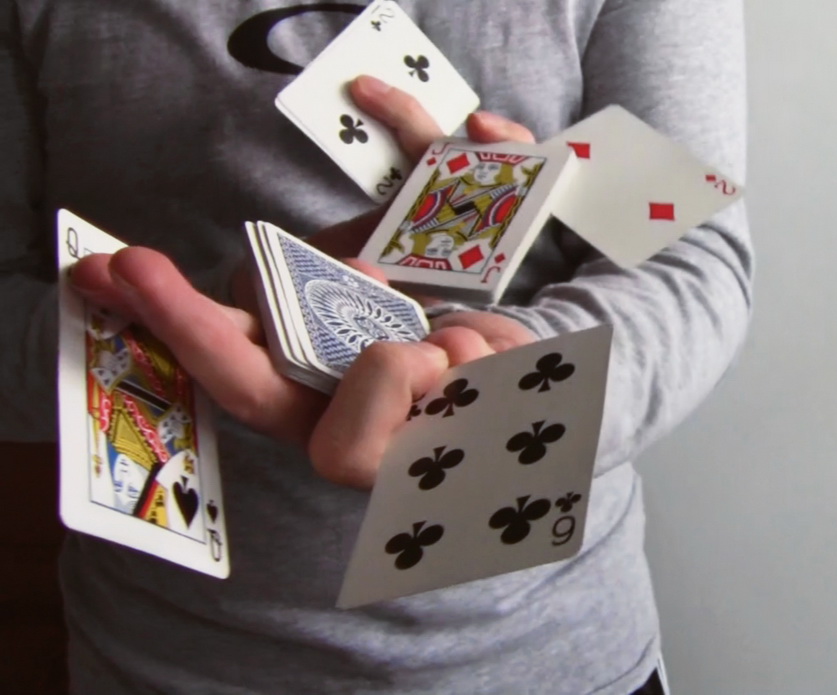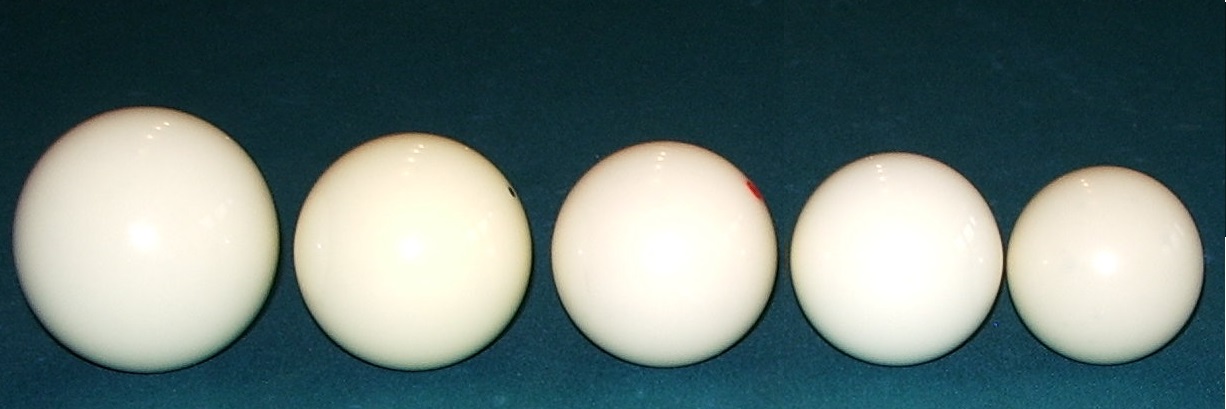|
Multiplying Billiard Balls
Multiplying billiard balls (Excelsior Ball Trick, August Roterberg, 1898) is a magic routine that is popular with both amateur and advanced conjurors but still rarely seen. As its name implies, the magician uses sleight of hand to manipulate a number of billiard balls (the balls are often smaller than actual billiard balls), giving the impression that he is making them appear and vanish at his command. Effect In this presentation, the magician will hold a single ball in his hand. The ball suddenly becomes two balls, in plain view of the audience. He then proceeds to produce a third and fourth ball, all in the same hand. The magician will then vanish the balls, one at a time, until only one remains. Often, part of the routine involves the magician giving the impression that he is "passing" the balls through his body, in and out of his mouth, fingertips, and pockets. Sets of multiplying billiard balls are available from magicians' supply stores. The quality, size, material, and ... [...More Info...] [...Related Items...] OR: [Wikipedia] [Google] [Baidu] |
August Roterberg
August Roterberg (1867–1928) was born in Hamburg, Germany and emigrated to the United States around 1883 as a teenager. He started out selling magic by mail order, and then opened a magic store in Chicago. It was housed in the lobby of the "old" Palmer House Hotel. Roterberg is credited for the advent of the modern age of magic publishing. His books were the first written in the English language expressly for magicians. Roterberg's books were published by a magic dealer specifically for sale in magical depots, rather than for wide distribution to the general public. He ended up selling his mail order business in 1908 to Ralph W. Read and his shop to Arthur & Carl Felsman in 1916. Roterberg is best known as a magic inventor and is credited with inventing the "Multiplying Billiard Balls" trick. He retired around 1917 and moved to California, where he lived until his death. Published works * ''The Modern Wizard''(1895) * ''Latter Day Tricks'' (1896) * ''New Era Card Tricks'' (18 ... [...More Info...] [...Related Items...] OR: [Wikipedia] [Google] [Baidu] |
Magic (illusion)
Magic, which encompasses the subgenres of illusion, stage magic, and close up magic, among others, is a performing art in which audiences are entertained by tricks, effects, or illusions of seemingly impossible feats, using natural means. It is to be distinguished from paranormal magic which are effects claimed to be created through supernatural means. It is one of the oldest performing arts in the world. Modern entertainment magic, as pioneered by 19th-century magician Jean-Eugène Robert-Houdin, has become a popular theatrical art form. In the late 19th and early 20th centuries, magicians such as Maskelyne and Devant, Howard Thurston, Harry Kellar, and Harry Houdini achieved widespread commercial success during what has become known as "the Golden Age of Magic." During this period, performance magic became a staple of Broadway theatre, vaudeville, and music halls. Magic retained its popularity in the television age, with magicians such as Paul Daniels, David Copperfield ... [...More Info...] [...Related Items...] OR: [Wikipedia] [Google] [Baidu] |
Sleight Of Hand
Sleight of hand (also known as prestidigitation or ''legerdemain'' ()) refers to fine motor skills when used by performing artists in different art forms to entertain or manipulate. It is closely associated with close-up magic, card magic, card flourishing and stealing. Because of its heavy use and practice by magicians, sleight of hand is often confused as a branch of magic; however, it is a separate genre of entertainment and many artists practice sleight of hand as an independent skill. Sleight of hand pioneers with worldwide acclaim include Dan and Dave, Ricky Jay, Derek DelGaudio, David Copperfield, Yann Frisch, Norbert Ferré, Dai Vernon, Cardini, Tony Slydini and Helder Guimarães. Etymology and history The word ''sleight'', meaning "the use of dexterity or cunning, especially so as to deceive", comes from the Old Norse. The phrase ''sleight of hand'' means "quick fingers" or "trickster fingers". Common synonyms of Latin and French include ''prestidigitation'' and ' ... [...More Info...] [...Related Items...] OR: [Wikipedia] [Google] [Baidu] |
Billiard Ball
A billiard ball is a small, hard ball used in cue sports, such as carom billiards, pool, and snooker. The number, type, diameter, color, and pattern of the balls differ depending upon the specific game being played. Various particular ball properties such as hardness, friction coefficient, and resilience are important to accuracy. History Early balls were made of various materials, including wood and clay (the latter remaining in use well into the 20th century). Although affordable ox-bone balls were in common use in Europe, elephant ivory was favored since at least 1627 until the early 20th century; the earliest known written reference to ivory billiard balls is in the 1588 inventory of the Duke of Norfolk. Dyed and numbered balls appeared around the early 1770s. By the mid-19th century, elephants were being slaughtered for their ivory at an alarming rate, just to keep up with the demand for high-end billiard balls – no more than eight balls could be made from a single ... [...More Info...] [...Related Items...] OR: [Wikipedia] [Google] [Baidu] |
Tom Stone (magician)
Tom Stone is the stage name of Thomas Bengtsson, a Swedish magician, editor and author. Biography Stone was born on October 28, 1967, and presently lives in Stockholm, Sweden. He is best known for writing a series of articles and pamphlets about original magical techniques and plots. He co-wrote a book with magician Lennart Green, contributed material to a book by Jason Alford, and has self-published a series of pamphlets as well as an e-book. He is also editor and publisher of various Swedish magic journals such as " Trollkarlen", and "Dr. Faustus Journal" (1995-). He has performed at the invitation-only Magic Castle, and in 2000, he was a "performer and speaker" at the FISM "World Championships of Magic" in Lisbon, Portugal. In 2003, he was a performer and competitor at the International Magic Convention & 20th Close Up competition in Kings Cross, London, where he won £500 and was awarded second place, just behind Japanese-Canadian magician Hayashi Hayashi ( 林, litera ... [...More Info...] [...Related Items...] OR: [Wikipedia] [Google] [Baidu] |
Buatier De Kolta
Buatier de Kolta (né Joseph Buatier; Caluire-et-Cuire, 18 November 1845 – New Orleans, 7 October 1903) was a French magician who performed throughout the latter part of the 1800s in Europe and America. Biography Joseph Buatier was born in Caluire-et-Cuire (Rhône, France). His parents were fabric merchants. He started reading books on magic at age six, and as a teenager he was already performing in amateur magic shows in his school. However his father, a devout Catholic, wanted him to become a priest, and persuaded him to enter a seminary. At age 18, he left it and worked as a painter, sharing a studio in Lyon with his more talented friend Elie-Joseph Laurent (1841–1926). He also resumed his performances as amateur magician, and one was noticed by Hungarian impresario Julius Vida de Kolta, who persuaded him to make magic his profession. His shows were immediately successful and he took the stage name Buatier de Kolta, acknowledging his debt to the impresario. In 1870, he s ... [...More Info...] [...Related Items...] OR: [Wikipedia] [Google] [Baidu] |



